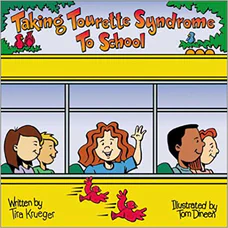Taking Tourette Syndrome To School

Recommended Age Range: 1st grade through 4th grade.
Publisher's Summary:
This beautifully illustrated and fun-to-read storybook tells the story of Megan, a kid living with Tourette Syndrome. When read aloud, other children can… begin to empathize with the peer. In addition, children with Tourette Syndrome or children who have conditions that set them apart as being different begin to feel accepted and safe. Book includes a Kid Quiz to reinforce new information and Ten Tips for Teachers to provide additional facts and ideas for teacher use.

Dr. Annie's Takeaways
Recommended for: This book’s primary purpose is to teach a child’s peers (classmates, teammates, etc.) about Tourette Syndrome so that a child is less likely to be teased or excluded due to their tics. It could be better written, but it’s an acceptable introduction to tics and Tourette Syndrome. It teaches peers important information, including facts like Tourette Syndrome isn’t contagious, and a child isn’t ever ticing on purpose, and it reminds readers that kids with Tourette Syndrome like to play and learn just like everyone else.
Tone: Upbeat, informative
Story Quality: This book is not the most well-written, and it has some odd transitions, but it’s more or less fine and serves a very useful purpose. It’s written in first person from the perspective of a kid with Tourette Syndrome.
Illustrations: Punchy digital cartoons in bold colors.
Representation: The narrator, Megan, is a White girl with Tourette Syndrome. The tics she experiences include sudden hand and knee movements, eye blinks, facial grimaces, coughs and “funny sounds.” The author has two children with Tourette Syndrome.
Psychological Practices: This book’s primary purpose is to explain tics and Tourette Syndrome to children who do not experience it so that they will be more likely to include and not tease a child with tics. It starts with a slightly odd definition of Tourette Syndrome: “Having Tourette Syndrome means that my nervous system, the part of my body that helps me move and feel, doesn’t always work the way it is supposed to.” This is basically accurate, but the language is a bit stigmatizing. Megan goes on to describe the experience of having a tic as being like an itch “you just had to scratch,” and she explains to children that they can’t catch Tourette Syndrome from her and that it’s “okay to be my friend and play with me.” She shares that she takes medicines to “help my nervous system relax” in order to reduce the frequency of her tics. She also shares that it helps her to get plenty of sleep and exercise and to be more relaxed. Megan reminds children that “when people tease me about my tics, I feel sad,” and she reminds readers that “I’m a lot like you in almost every other way!”
Concerns: If a child is not experiencing teasing from other kids about their tics, this book could introduce the possibility and make them more self-conscious about it. It is best for kids whose peers have noticed a child’s tics and have questions or are starting to tease or make comments. Additionally, Megan states that “having tics is something I can’t help,” which might not be fully accurate. Although it’s true that tics feel involuntary and they are certainly not an active choice, Habit Reversal Therapy
is an evidence-based treatment which helps children increase their ability to manage their tics. If a child is starting this type of therapy, I would not want them to get the message that they are totally powerless when it comes to managing their tics.
